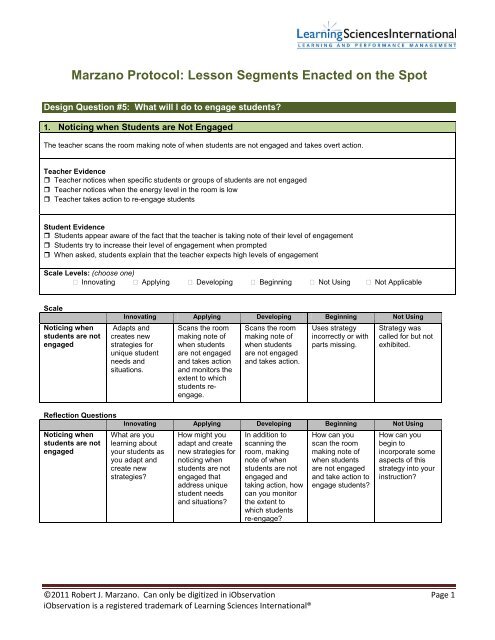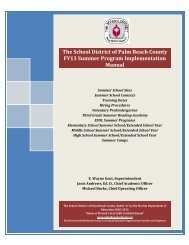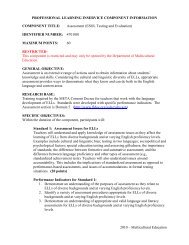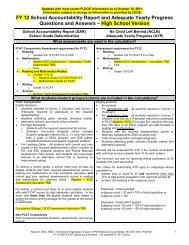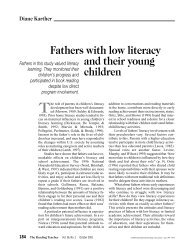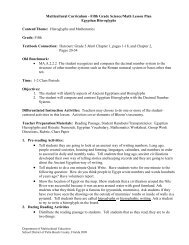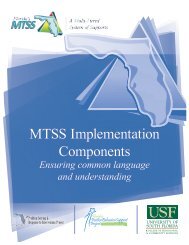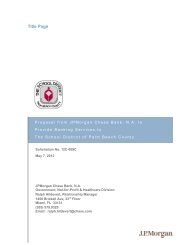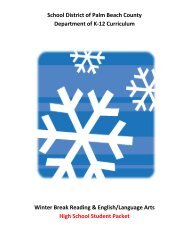Marzano Protocol: Lesson Segments Enacted on the Spot
Marzano Protocol: Lesson Segments Enacted on the Spot
Marzano Protocol: Lesson Segments Enacted on the Spot
Create successful ePaper yourself
Turn your PDF publications into a flip-book with our unique Google optimized e-Paper software.
<str<strong>on</strong>g>Marzano</str<strong>on</strong>g> <str<strong>on</strong>g>Protocol</str<strong>on</strong>g>: <str<strong>on</strong>g>Less<strong>on</strong></str<strong>on</strong>g> <str<strong>on</strong>g>Segments</str<strong>on</strong>g> <str<strong>on</strong>g>Enacted</str<strong>on</strong>g> <strong>on</strong> <strong>the</strong> <strong>Spot</strong><br />
Design Questi<strong>on</strong> #5: What will I do to engage students?<br />
1. Noticing when Students are Not Engaged<br />
The teacher scans <strong>the</strong> room making note of when students are not engaged and takes overt acti<strong>on</strong>.<br />
Teacher Evidence<br />
Teacher notices when specific students or groups of students are not engaged<br />
Teacher notices when <strong>the</strong> energy level in <strong>the</strong> room is low<br />
Teacher takes acti<strong>on</strong> to re-engage students<br />
Student Evidence<br />
Students appear aware of <strong>the</strong> fact that <strong>the</strong> teacher is taking note of <strong>the</strong>ir level of engagement<br />
Students try to increase <strong>the</strong>ir level of engagement when prompted<br />
When asked, students explain that <strong>the</strong> teacher expects high levels of engagement<br />
Scale Levels: (choose <strong>on</strong>e)<br />
Innovating Applying Developing Beginning Not Using Not Applicable<br />
Scale<br />
Noticing when<br />
students are not<br />
engaged<br />
Innovating Applying Developing Beginning Not Using<br />
Adapts and<br />
creates new<br />
strategies for<br />
unique student<br />
needs and<br />
situati<strong>on</strong>s.<br />
Scans <strong>the</strong> room<br />
making note of<br />
when students<br />
are not engaged<br />
and takes acti<strong>on</strong><br />
and m<strong>on</strong>itors <strong>the</strong><br />
extent to which<br />
students reengage.<br />
Scans <strong>the</strong> room<br />
making note of<br />
when students<br />
are not engaged<br />
and takes acti<strong>on</strong>.<br />
Uses strategy<br />
incorrectly or with<br />
parts missing.<br />
Strategy was<br />
called for but not<br />
exhibited.<br />
Reflecti<strong>on</strong> Questi<strong>on</strong>s<br />
Noticing when<br />
students are not<br />
engaged<br />
Innovating Applying Developing Beginning Not Using<br />
What are you<br />
learning about<br />
your students as<br />
you adapt and<br />
create new<br />
strategies?<br />
How might you<br />
adapt and create<br />
new strategies for<br />
noticing when<br />
students are not<br />
engaged that<br />
address unique<br />
student needs<br />
and situati<strong>on</strong>s?<br />
In additi<strong>on</strong> to<br />
scanning <strong>the</strong><br />
room, making<br />
note of when<br />
students are not<br />
engaged and<br />
taking acti<strong>on</strong>, how<br />
can you m<strong>on</strong>itor<br />
<strong>the</strong> extent to<br />
which students<br />
re-engage?<br />
How can you<br />
scan <strong>the</strong> room<br />
making note of<br />
when students<br />
are not engaged<br />
and take acti<strong>on</strong> to<br />
engage students?<br />
How can you<br />
begin to<br />
incorporate some<br />
aspects of this<br />
strategy into your<br />
instructi<strong>on</strong>?<br />
©2011 Robert J. <str<strong>on</strong>g>Marzano</str<strong>on</strong>g>. Can <strong>on</strong>ly be digitized in iObservati<strong>on</strong> Page 1<br />
iObservati<strong>on</strong> is a registered trademark of Learning Sciences Internati<strong>on</strong>al®
2. Using Academic Games<br />
The teacher uses academic games and inc<strong>on</strong>sequential competiti<strong>on</strong> to maintain student engagement.<br />
Teacher Evidence<br />
Teacher uses structured games such as Jeopardy, family feud, and <strong>the</strong> like<br />
Teacher develops impromptu games such as making a game out of which answer might be correct for a given questi<strong>on</strong><br />
Teacher uses friendly competiti<strong>on</strong> al<strong>on</strong>g with classroom games<br />
Student Evidence<br />
Students engage in <strong>the</strong> games with some enthusiasm<br />
When asked, students can explain how <strong>the</strong> games keep <strong>the</strong>ir interest and help <strong>the</strong>m learn or remember c<strong>on</strong>tent<br />
Scale Levels: (choose <strong>on</strong>e)<br />
Innovating Applying Developing Beginning Not Using Not Applicable<br />
Scale<br />
Using academic<br />
games<br />
Innovating Applying Developing Beginning Not Using<br />
Adapts and<br />
creates new<br />
strategies for<br />
unique student<br />
needs and<br />
situati<strong>on</strong>s.<br />
Uses academic<br />
games and<br />
inc<strong>on</strong>sequential<br />
competiti<strong>on</strong> to<br />
maintain student<br />
engagement and<br />
m<strong>on</strong>itors <strong>the</strong><br />
extent to which<br />
students focus <strong>on</strong><br />
<strong>the</strong> academic<br />
c<strong>on</strong>tent of <strong>the</strong><br />
game.<br />
Uses academic<br />
games and<br />
inc<strong>on</strong>sequential<br />
competiti<strong>on</strong> to<br />
maintain student<br />
engagement.<br />
Uses strategy<br />
incorrectly or with<br />
parts missing.<br />
Strategy was<br />
called for but not<br />
exhibited.<br />
Reflecti<strong>on</strong> Questi<strong>on</strong>s<br />
Using academic<br />
games<br />
Innovating Applying Developing Beginning Not Using<br />
What are you<br />
learning about<br />
your students as<br />
you adapt and<br />
create new<br />
strategies?<br />
How might you<br />
adapt and create<br />
new strategies for<br />
using academic<br />
games and<br />
inc<strong>on</strong>sequential<br />
competiti<strong>on</strong> to<br />
maintain student<br />
engagement that<br />
address unique<br />
student needs<br />
and situati<strong>on</strong>s?<br />
In additi<strong>on</strong> to<br />
using academic<br />
games and<br />
inc<strong>on</strong>sequential<br />
competiti<strong>on</strong> to<br />
maintain student<br />
engagement, how<br />
can you m<strong>on</strong>itor<br />
<strong>the</strong> extent to<br />
which students<br />
focus <strong>on</strong> <strong>the</strong><br />
academic c<strong>on</strong>tent<br />
of <strong>the</strong> game?<br />
How can you use<br />
academic games<br />
and<br />
inc<strong>on</strong>sequential<br />
competiti<strong>on</strong> to<br />
maintain student<br />
engagement?<br />
How can you<br />
begin to<br />
incorporate this<br />
strategy into your<br />
instructi<strong>on</strong>?<br />
©2011 Robert J. <str<strong>on</strong>g>Marzano</str<strong>on</strong>g>. Can <strong>on</strong>ly be digitized in iObservati<strong>on</strong> Page 2<br />
iObservati<strong>on</strong> is a registered trademark of Learning Sciences Internati<strong>on</strong>al®
3. Managing Resp<strong>on</strong>se Rates<br />
The teacher uses resp<strong>on</strong>se rate techniques to maintain student engagement in questi<strong>on</strong>s.<br />
Teacher Evidence<br />
Teacher uses wait time<br />
Teacher uses resp<strong>on</strong>se cards<br />
Teacher has students use hand signals to resp<strong>on</strong>d to questi<strong>on</strong>s<br />
Teacher uses choral resp<strong>on</strong>se<br />
Teacher uses technology to keep track of students’ resp<strong>on</strong>ses<br />
Teacher uses resp<strong>on</strong>se chaining<br />
Student Evidence<br />
Multiple students or <strong>the</strong> entire class resp<strong>on</strong>ds to questi<strong>on</strong>s posed by <strong>the</strong> teacher<br />
When asked, students can describe <strong>the</strong>ir thinking about specific questi<strong>on</strong>s posed by <strong>the</strong> teacher<br />
Scale Levels: (choose <strong>on</strong>e)<br />
Innovating Applying Developing Beginning Not Using Not Applicable<br />
Scale<br />
Managing<br />
resp<strong>on</strong>se rates<br />
Innovating Applying Developing Beginning Not Using<br />
Adapts and<br />
creates new<br />
strategies for<br />
unique student<br />
needs and<br />
situati<strong>on</strong>s.<br />
Uses resp<strong>on</strong>se<br />
rate techniques to<br />
maintain student<br />
engagement in<br />
questi<strong>on</strong>s and<br />
m<strong>on</strong>itors <strong>the</strong><br />
extent to which<br />
<strong>the</strong> techniques<br />
keep students<br />
engaged.<br />
Uses resp<strong>on</strong>se<br />
rate techniques to<br />
maintain student<br />
engagement in<br />
questi<strong>on</strong>s.<br />
Uses strategy<br />
incorrectly or with<br />
parts missing.<br />
Strategy was<br />
called for but not<br />
exhibited.<br />
Reflecti<strong>on</strong> Questi<strong>on</strong>s<br />
Managing<br />
resp<strong>on</strong>se rates<br />
Innovating Applying Developing Beginning Not Using<br />
What are you<br />
learning about<br />
your students as<br />
you adapt and<br />
create new<br />
strategies?<br />
How might you<br />
adapt and create<br />
new resp<strong>on</strong>se<br />
rate techniques to<br />
maintain student<br />
engagement in<br />
questi<strong>on</strong>s that<br />
address unique<br />
student needs<br />
and situati<strong>on</strong>s?<br />
In additi<strong>on</strong> to<br />
using resp<strong>on</strong>se<br />
rate techniques to<br />
maintain student<br />
engagement in<br />
questi<strong>on</strong>s, how<br />
can you m<strong>on</strong>itor<br />
<strong>the</strong> extent to<br />
which <strong>the</strong><br />
techniques keep<br />
students<br />
engaged?<br />
How can you use<br />
resp<strong>on</strong>se rate<br />
techniques to<br />
maintain student<br />
engagement in<br />
questi<strong>on</strong>s?<br />
How can you<br />
begin to<br />
incorporate this<br />
strategy into your<br />
instructi<strong>on</strong>?<br />
©2011 Robert J. <str<strong>on</strong>g>Marzano</str<strong>on</strong>g>. Can <strong>on</strong>ly be digitized in iObservati<strong>on</strong> Page 3<br />
iObservati<strong>on</strong> is a registered trademark of Learning Sciences Internati<strong>on</strong>al®
4. Using Physical Movement<br />
The teacher uses physical movement to maintain student engagement.<br />
Teacher Evidence<br />
Teacher has students stand up and stretch or related activities when <strong>the</strong>ir energy is low<br />
Teacher uses activities that require students to physically move to resp<strong>on</strong>d to questi<strong>on</strong>s<br />
• Vote with your feet<br />
• Go to <strong>the</strong> part of <strong>the</strong> room that represents <strong>the</strong> answer you agree with<br />
Teacher has students physically act out or model c<strong>on</strong>tent to increase energy and engagement<br />
Teacher use give-<strong>on</strong>e-get-<strong>on</strong>e activities that require students to move about <strong>the</strong> room<br />
Student Evidence<br />
Students engage in <strong>the</strong> physical activities designed by <strong>the</strong> teacher<br />
When asked, students can explain how <strong>the</strong> physical movement keeps <strong>the</strong>ir interest and helps <strong>the</strong>m learn<br />
Scale Levels: (choose <strong>on</strong>e)<br />
Innovating Applying Developing Beginning Not Using Not Applicable<br />
Scale<br />
Using physical<br />
movement<br />
Innovating Applying Developing Beginning Not Using<br />
Adapts and<br />
creates new<br />
strategies for<br />
unique student<br />
needs and<br />
situati<strong>on</strong>s.<br />
Uses physical<br />
movement to<br />
maintain student<br />
engagement and<br />
m<strong>on</strong>itors <strong>the</strong><br />
extent to which<br />
<strong>the</strong>se activities<br />
enhance student<br />
engagement.<br />
Uses physical<br />
movement to<br />
maintain student<br />
engagement.<br />
Uses strategy<br />
incorrectly or with<br />
parts missing.<br />
Strategy was<br />
called for but not<br />
exhibited.<br />
Reflecti<strong>on</strong> Questi<strong>on</strong>s<br />
Using physical<br />
movement<br />
Innovating Applying Developing Beginning Not Using<br />
What are you<br />
learning about<br />
your students as<br />
you adapt and<br />
create new<br />
strategies?<br />
How might you<br />
adapt and create<br />
new physical<br />
movement<br />
techniques to<br />
maintain student<br />
engagement that<br />
address unique<br />
student needs<br />
and situati<strong>on</strong>s?<br />
In additi<strong>on</strong> to<br />
using physical<br />
movement to<br />
maintain student<br />
engagement, how<br />
can you m<strong>on</strong>itor<br />
<strong>the</strong> extent to<br />
which <strong>the</strong>se<br />
activities enhance<br />
student<br />
engagement?<br />
How can you use<br />
physical<br />
movement to<br />
maintain student<br />
engagement?<br />
How can you<br />
begin to<br />
incorporate this<br />
strategy into your<br />
instructi<strong>on</strong>?<br />
©2011 Robert J. <str<strong>on</strong>g>Marzano</str<strong>on</strong>g>. Can <strong>on</strong>ly be digitized in iObservati<strong>on</strong> Page 4<br />
iObservati<strong>on</strong> is a registered trademark of Learning Sciences Internati<strong>on</strong>al®
5. Maintaining a Lively Pace<br />
The teacher uses pacing techniques to maintain students’ engagement.<br />
Teacher Evidence<br />
Teacher employs crisp transiti<strong>on</strong>s from <strong>on</strong>e activity to ano<strong>the</strong>r<br />
Teacher alters pace appropriately (i.e. speeds up and slows down)<br />
Student Evidence<br />
Students quickly adapt to transiti<strong>on</strong>s and re-engage when a new activity is begun<br />
When asked about <strong>the</strong> pace of <strong>the</strong> class, students describe it as not too fast or not too slow<br />
Scale Levels: (choose <strong>on</strong>e)<br />
Innovating Applying Developing Beginning Not Using Not Applicable<br />
Scale<br />
Maintaining a<br />
lively pace<br />
Innovating Applying Developing Beginning Not Using<br />
Adapts and<br />
creates new<br />
strategies for<br />
unique student<br />
needs and<br />
situati<strong>on</strong>s.<br />
Uses pacing<br />
techniques to<br />
maintain<br />
students’<br />
engagement and<br />
m<strong>on</strong>itors <strong>the</strong><br />
extent to which<br />
<strong>the</strong>se techniques<br />
keep students<br />
engaged.<br />
Uses pacing<br />
techniques to<br />
maintain<br />
students’<br />
engagement.<br />
Uses strategy<br />
incorrectly or with<br />
parts missing.<br />
Strategy was<br />
called for but not<br />
exhibited.<br />
Reflecti<strong>on</strong> Questi<strong>on</strong>s<br />
Maintaining a<br />
lively pace<br />
Innovating Applying Developing Beginning Not Using<br />
What are you<br />
learning about<br />
your students as<br />
you adapt and<br />
create new<br />
strategies?<br />
How might you<br />
adapt and create<br />
new pacing<br />
techniques that<br />
address unique<br />
student needs<br />
and situati<strong>on</strong>s?<br />
In additi<strong>on</strong> to<br />
pacing<br />
techniques to<br />
maintain<br />
students’<br />
engagement, how<br />
can you m<strong>on</strong>itor<br />
<strong>the</strong> extent to<br />
which students<br />
keep engaged?<br />
How can you use<br />
pacing<br />
techniques to<br />
maintain<br />
students’<br />
engagement?<br />
How can you<br />
begin to<br />
incorporate this<br />
strategy into your<br />
instructi<strong>on</strong>?<br />
©2011 Robert J. <str<strong>on</strong>g>Marzano</str<strong>on</strong>g>. Can <strong>on</strong>ly be digitized in iObservati<strong>on</strong> Page 5<br />
iObservati<strong>on</strong> is a registered trademark of Learning Sciences Internati<strong>on</strong>al®
6. Dem<strong>on</strong>strating Intensity and Enthusiasm<br />
The teacher dem<strong>on</strong>strates intensity and enthusiasm for <strong>the</strong> c<strong>on</strong>tent in a variety of ways.<br />
Teacher Evidence<br />
Teacher describes pers<strong>on</strong>al experiences that relate to <strong>the</strong> c<strong>on</strong>tent<br />
Teacher signals excitement for c<strong>on</strong>tent by:<br />
• Physical gestures<br />
• Voice t<strong>on</strong>e<br />
• Dramatizati<strong>on</strong> of informati<strong>on</strong><br />
Teacher overtly adjusts energy level<br />
Student Evidence<br />
When asked, students say that <strong>the</strong> teacher “likes <strong>the</strong> c<strong>on</strong>tent” and “likes teaching”<br />
Students’ attenti<strong>on</strong> levels increase when <strong>the</strong> teacher dem<strong>on</strong>strates enthusiasm and intensity for <strong>the</strong> c<strong>on</strong>tent<br />
Scale Levels: (choose <strong>on</strong>e)<br />
Innovating Applying Developing Beginning Not Using Not Applicable<br />
Scale<br />
Dem<strong>on</strong>strating<br />
intensity and<br />
enthusiasm<br />
Innovating Applying Developing Beginning Not Using<br />
Adapts and<br />
creates new<br />
strategies for<br />
unique student<br />
needs and<br />
situati<strong>on</strong>s.<br />
Dem<strong>on</strong>strates<br />
intensity and<br />
enthusiasm for<br />
<strong>the</strong> c<strong>on</strong>tent in a<br />
variety of ways<br />
and m<strong>on</strong>itors <strong>the</strong><br />
extent to which<br />
students’<br />
engagement<br />
increases.<br />
Dem<strong>on</strong>strates<br />
intensity and<br />
enthusiasm for<br />
<strong>the</strong> c<strong>on</strong>tent in a<br />
variety of ways.<br />
Uses strategy<br />
incorrectly or with<br />
parts missing.<br />
Strategy was<br />
called for but not<br />
exhibited.<br />
Reflecti<strong>on</strong> Questi<strong>on</strong>s<br />
Dem<strong>on</strong>strating<br />
intensity and<br />
enthusiasm<br />
Innovating Applying Developing Beginning Not Using<br />
What are you<br />
learning about<br />
your students as<br />
you adapt and<br />
create new<br />
strategies?<br />
How might you<br />
adapt and create<br />
new techniques<br />
for dem<strong>on</strong>strating<br />
intensity and<br />
enthusiasm for<br />
<strong>the</strong> c<strong>on</strong>tent that<br />
address unique<br />
student needs<br />
and situati<strong>on</strong>s?<br />
In additi<strong>on</strong> to<br />
dem<strong>on</strong>strating<br />
intensity and<br />
enthusiasm for<br />
<strong>the</strong> c<strong>on</strong>tent in a<br />
variety of ways,<br />
how can you<br />
m<strong>on</strong>itor <strong>the</strong> extent<br />
to which students<br />
keep engaged?<br />
How can you<br />
dem<strong>on</strong>strate<br />
intensity and<br />
enthusiasm for<br />
<strong>the</strong> c<strong>on</strong>tent in a<br />
variety of ways?<br />
How can you<br />
begin to<br />
incorporate this<br />
strategy into your<br />
instructi<strong>on</strong>?<br />
©2011 Robert J. <str<strong>on</strong>g>Marzano</str<strong>on</strong>g>. Can <strong>on</strong>ly be digitized in iObservati<strong>on</strong> Page 6<br />
iObservati<strong>on</strong> is a registered trademark of Learning Sciences Internati<strong>on</strong>al®
7. Using Friendly C<strong>on</strong>troversy<br />
The teacher uses friendly c<strong>on</strong>troversy techniques to maintain student engagement.<br />
Teacher Evidence<br />
Teacher structures mini-debates about <strong>the</strong> c<strong>on</strong>tent<br />
Teacher has students examine multiple perspectives and opini<strong>on</strong>s about <strong>the</strong> c<strong>on</strong>tent<br />
Teacher elicits different opini<strong>on</strong>s <strong>on</strong> c<strong>on</strong>tent from members of <strong>the</strong> class<br />
Student Evidence<br />
Students engage in friendly c<strong>on</strong>troversy activities with enhanced engagement<br />
When asked, students describe friendly c<strong>on</strong>troversy activities as “stimulating,” “fun,” and so <strong>on</strong>.<br />
When asked, students explain how a friendly c<strong>on</strong>troversy activity helped <strong>the</strong>m better understand <strong>the</strong> c<strong>on</strong>tent<br />
Scale Levels: (choose <strong>on</strong>e)<br />
Innovating Applying Developing Beginning Not Using Not Applicable<br />
Scale<br />
Using friendly<br />
c<strong>on</strong>troversy<br />
Innovating Applying Developing Beginning Not Using<br />
Adapts and<br />
creates new<br />
strategies for<br />
unique student<br />
needs and<br />
situati<strong>on</strong>s.<br />
Uses friendly<br />
c<strong>on</strong>troversy<br />
techniques to<br />
maintain student<br />
engagement and<br />
m<strong>on</strong>itors <strong>the</strong><br />
effect <strong>on</strong><br />
students’<br />
engagement.<br />
Uses friendly<br />
c<strong>on</strong>troversy<br />
techniques to<br />
maintain student<br />
engagement.<br />
Uses strategy<br />
incorrectly or with<br />
parts missing.<br />
Strategy was<br />
called for but not<br />
exhibited.<br />
Reflecti<strong>on</strong> Questi<strong>on</strong>s<br />
Using friendly<br />
c<strong>on</strong>troversy<br />
Innovating Applying Developing Beginning Not Using<br />
What are you<br />
learning about<br />
your students as<br />
you adapt and<br />
create new<br />
strategies?<br />
How might you<br />
adapt and create<br />
new techniques<br />
for using friendly<br />
c<strong>on</strong>troversy to<br />
maintain student<br />
engagement that<br />
address unique<br />
student needs<br />
and situati<strong>on</strong>s?<br />
In additi<strong>on</strong> to<br />
using friendly<br />
c<strong>on</strong>troversy<br />
techniques to<br />
maintain student<br />
engagement, how<br />
can you m<strong>on</strong>itor<br />
<strong>the</strong> extent to<br />
which students<br />
keep engaged?<br />
How can you use<br />
friendly<br />
c<strong>on</strong>troversy<br />
techniques to<br />
maintain student<br />
engagement?<br />
How can you<br />
begin to<br />
incorporate this<br />
strategy into your<br />
instructi<strong>on</strong>?<br />
©2011 Robert J. <str<strong>on</strong>g>Marzano</str<strong>on</strong>g>. Can <strong>on</strong>ly be digitized in iObservati<strong>on</strong> Page 7<br />
iObservati<strong>on</strong> is a registered trademark of Learning Sciences Internati<strong>on</strong>al®
8. Providing Opportunities for Students to Talk about Themselves<br />
The teacher provides students with opportunities to relate what is being addressed in class to <strong>the</strong>ir pers<strong>on</strong>al interests.<br />
Teacher Evidence<br />
Teacher is aware of student interests and makes c<strong>on</strong>necti<strong>on</strong>s between <strong>the</strong>se interests and class c<strong>on</strong>tent<br />
Teacher structures activities that ask students to make c<strong>on</strong>necti<strong>on</strong>s between <strong>the</strong> c<strong>on</strong>tent and <strong>the</strong>ir pers<strong>on</strong>al interests<br />
When students are explaining how c<strong>on</strong>tent relates to <strong>the</strong>ir pers<strong>on</strong>al interests, <strong>the</strong> teacher appears encouraging and<br />
interested<br />
Student Evidence<br />
Students engage in activities that require <strong>the</strong>m to make c<strong>on</strong>necti<strong>on</strong>s between <strong>the</strong>ir pers<strong>on</strong>al interests and <strong>the</strong> c<strong>on</strong>tent<br />
When asked, students explain how making c<strong>on</strong>necti<strong>on</strong>s between c<strong>on</strong>tent and <strong>the</strong>ir pers<strong>on</strong>al interests engages <strong>the</strong>m and<br />
helps <strong>the</strong>m better understand <strong>the</strong> c<strong>on</strong>tent<br />
Scale Levels: (choose <strong>on</strong>e)<br />
Innovating Applying Developing Beginning Not Using Not Applicable<br />
Scale<br />
Providing<br />
opportunities for<br />
students to talk<br />
about<br />
<strong>the</strong>mselves<br />
Innovating Applying Developing Beginning Not Using<br />
Adapts and<br />
creates new<br />
strategies for<br />
unique student<br />
needs and<br />
situati<strong>on</strong>s.<br />
Provides students<br />
with opportunities<br />
to relate what is<br />
being addressed<br />
in class to <strong>the</strong>ir<br />
pers<strong>on</strong>al interests<br />
and m<strong>on</strong>itors <strong>the</strong><br />
extent to which<br />
<strong>the</strong>se activities<br />
enhance student<br />
engagement.<br />
Provides students<br />
with opportunities<br />
to relate what is<br />
being addressed<br />
in class to <strong>the</strong>ir<br />
pers<strong>on</strong>al<br />
interests.<br />
Uses strategy<br />
incorrectly or with<br />
parts missing.<br />
Strategy was<br />
called for but not<br />
exhibited.<br />
Reflecti<strong>on</strong> Questi<strong>on</strong>s<br />
Providing<br />
opportunities for<br />
students to talk<br />
about<br />
<strong>the</strong>mselves<br />
Innovating Applying Developing Beginning Not Using<br />
What are you<br />
learning about<br />
your students as<br />
you adapt and<br />
create new<br />
strategies?<br />
How might you<br />
adapt and create<br />
new techniques<br />
for providing<br />
students with<br />
opportunities to<br />
relate what is<br />
being addressed<br />
in class to <strong>the</strong>ir<br />
pers<strong>on</strong>al interests<br />
that address<br />
unique student<br />
needs and<br />
situati<strong>on</strong>s?<br />
In additi<strong>on</strong> to<br />
providing<br />
students with<br />
opportunities to<br />
relate what is<br />
being addressed<br />
in class to <strong>the</strong>ir<br />
pers<strong>on</strong>al<br />
interests, how<br />
can you m<strong>on</strong>itor<br />
<strong>the</strong> extent to<br />
which <strong>the</strong>se<br />
activities enhance<br />
student<br />
engagement?<br />
How can you<br />
provide students<br />
with opportunities<br />
to relate what is<br />
being addressed<br />
in class to <strong>the</strong>ir<br />
pers<strong>on</strong>al<br />
interests?<br />
How can you<br />
begin to<br />
incorporate this<br />
strategy into your<br />
instructi<strong>on</strong>?<br />
©2011 Robert J. <str<strong>on</strong>g>Marzano</str<strong>on</strong>g>. Can <strong>on</strong>ly be digitized in iObservati<strong>on</strong> Page 8<br />
iObservati<strong>on</strong> is a registered trademark of Learning Sciences Internati<strong>on</strong>al®
9. Presenting Unusual or Intriguing Informati<strong>on</strong><br />
The teacher uses unusual or intriguing informati<strong>on</strong> about <strong>the</strong> c<strong>on</strong>tent in a manner that enhances student engagement.<br />
Teacher Evidence<br />
Teacher systematically provides interesting facts and details about <strong>the</strong> c<strong>on</strong>tent<br />
Teacher encourages students to identify interesting informati<strong>on</strong> about <strong>the</strong> c<strong>on</strong>tent<br />
Teacher engages students in activities like “Believe it or not” about <strong>the</strong> c<strong>on</strong>tent<br />
Teacher uses guest speakers to provide unusual informati<strong>on</strong> about <strong>the</strong> c<strong>on</strong>tent<br />
Student Evidence<br />
Students’ attenti<strong>on</strong> increases when unusual informati<strong>on</strong> is presented about <strong>the</strong> c<strong>on</strong>tent<br />
When asked, students explain how <strong>the</strong> unusual informati<strong>on</strong> makes <strong>the</strong>m more interested in <strong>the</strong> c<strong>on</strong>tent<br />
Scale Levels: (choose <strong>on</strong>e)<br />
Innovating Applying Developing Beginning Not Using Not Applicable<br />
Scale<br />
Presenting<br />
unusual or<br />
intriguing<br />
informati<strong>on</strong><br />
Innovating Applying Developing Beginning Not Using<br />
Adapts and<br />
creates new<br />
strategies for<br />
unique student<br />
needs and<br />
situati<strong>on</strong>s.<br />
Uses unusual or<br />
intriguing<br />
informati<strong>on</strong> about<br />
<strong>the</strong> c<strong>on</strong>tent and<br />
m<strong>on</strong>itors <strong>the</strong><br />
extent to which<br />
this informati<strong>on</strong><br />
enhances<br />
students’ interest<br />
in <strong>the</strong> c<strong>on</strong>tent.<br />
Uses unusual or<br />
intriguing<br />
informati<strong>on</strong> about<br />
<strong>the</strong> c<strong>on</strong>tent.<br />
Uses strategy<br />
incorrectly or with<br />
parts missing.<br />
Strategy was<br />
called for but not<br />
exhibited.<br />
Reflecti<strong>on</strong> Questi<strong>on</strong>s<br />
Presenting<br />
unusual or<br />
intriguing<br />
informati<strong>on</strong><br />
Innovating Applying Developing Beginning Not Using<br />
What are you<br />
learning about<br />
your students as<br />
you adapt and<br />
create new<br />
strategies?<br />
How might you<br />
adapt and create<br />
new techniques<br />
for using unusual<br />
or intriguing<br />
informati<strong>on</strong> about<br />
<strong>the</strong> c<strong>on</strong>tent that<br />
address unique<br />
student needs<br />
and situati<strong>on</strong>s?<br />
In additi<strong>on</strong> to<br />
using unusual or<br />
intriguing<br />
informati<strong>on</strong> about<br />
<strong>the</strong> c<strong>on</strong>tent, how<br />
can you m<strong>on</strong>itor<br />
<strong>the</strong> extent to<br />
which this<br />
informati<strong>on</strong><br />
enhances<br />
students’ interest<br />
in <strong>the</strong> c<strong>on</strong>tent?<br />
How can you use<br />
unusual or<br />
intriguing<br />
informati<strong>on</strong> about<br />
<strong>the</strong> c<strong>on</strong>tent?<br />
How can you<br />
begin to<br />
incorporate this<br />
strategy into your<br />
instructi<strong>on</strong>?<br />
10. Student Interviews<br />
Student Questi<strong>on</strong>s:<br />
• How engaged were you in this less<strong>on</strong>?<br />
• What are some things that keep your attenti<strong>on</strong>?<br />
• What are some things that made you bored?<br />
©2011 Robert J. <str<strong>on</strong>g>Marzano</str<strong>on</strong>g>. Can <strong>on</strong>ly be digitized in iObservati<strong>on</strong> Page 9<br />
iObservati<strong>on</strong> is a registered trademark of Learning Sciences Internati<strong>on</strong>al®
Design Questi<strong>on</strong> #7: What will I do to recognize and acknowledge adherence or lack of<br />
adherence to rules and procedures?<br />
1. Dem<strong>on</strong>strating “Withitness”<br />
The teacher uses behaviors associated with “withitness” to maintain adherence to rules and procedures.<br />
Teacher Evidence<br />
Teacher physically occupies all quadrants of <strong>the</strong> room<br />
Teacher scans <strong>the</strong> entire room making eye c<strong>on</strong>tact with all students<br />
Teacher recognizes potential sources of disrupti<strong>on</strong> and deals with <strong>the</strong>m immediately<br />
Teacher proactively addresses inflammatory situati<strong>on</strong>s<br />
Student Evidence<br />
Students recognize that <strong>the</strong> teacher is aware of <strong>the</strong>ir behavior<br />
When asked, students describe <strong>the</strong> teacher as “aware of what is going <strong>on</strong>” or “has eyes <strong>on</strong> <strong>the</strong> back of his/her head”<br />
Scale Levels: (choose <strong>on</strong>e)<br />
Innovating Applying Developing Beginning Not Using Not Applicable<br />
Scale<br />
Dem<strong>on</strong>strating<br />
“withitness”<br />
Innovating Applying Developing Beginning Not Using<br />
Adapts and<br />
creates new<br />
strategies for<br />
unique student<br />
needs and<br />
situati<strong>on</strong>s.<br />
Uses behaviors<br />
associated with<br />
“withitness” and<br />
m<strong>on</strong>itors <strong>the</strong><br />
effect <strong>on</strong><br />
students’<br />
behavior.<br />
Uses behaviors<br />
associated with<br />
“withitness”.<br />
Uses strategy<br />
incorrectly or with<br />
parts missing.<br />
Strategy was<br />
called for but not<br />
exhibited.<br />
Reflecti<strong>on</strong> Questi<strong>on</strong>s<br />
Dem<strong>on</strong>strating<br />
“withitness”<br />
Innovating Applying Developing Beginning Not Using<br />
What are you<br />
learning about<br />
your students as<br />
you adapt and<br />
create new<br />
strategies?<br />
How might you<br />
adapt and create<br />
new techniques<br />
for using<br />
behaviors<br />
associated with<br />
“withitness” that<br />
address unique<br />
student needs<br />
and situati<strong>on</strong>s?<br />
In additi<strong>on</strong> to,<br />
using behaviors<br />
associated with<br />
“withitness,” how<br />
can you m<strong>on</strong>itor<br />
<strong>the</strong> effect <strong>on</strong><br />
students’<br />
behavior?<br />
How can you use<br />
behaviors<br />
associated with<br />
“withitness”?<br />
How can you<br />
begin to<br />
incorporate this<br />
strategy into your<br />
instructi<strong>on</strong>?<br />
©2011 Robert J. <str<strong>on</strong>g>Marzano</str<strong>on</strong>g>. Can <strong>on</strong>ly be digitized in iObservati<strong>on</strong> Page 10<br />
iObservati<strong>on</strong> is a registered trademark of Learning Sciences Internati<strong>on</strong>al®
2. Applying C<strong>on</strong>sequences for Lack of Adherence to Rules and Procedures<br />
The teacher applies c<strong>on</strong>sequences for not following rules and procedures c<strong>on</strong>sistently and fairly.<br />
Teacher Evidence<br />
Teacher provides n<strong>on</strong>verbal signals when students’ behavior is not appropriate<br />
• Eye c<strong>on</strong>tact<br />
• Proximity<br />
• Tap <strong>on</strong> <strong>the</strong> desk<br />
• Shaking head, no<br />
Teacher provides verbal signals when students’ behavior is not appropriate<br />
• Tells students to stop<br />
• Tells students that <strong>the</strong>ir behavior is in violati<strong>on</strong> of a rule or procedure<br />
Teacher uses group c<strong>on</strong>tingency c<strong>on</strong>sequences when appropriate (i.e. whole group must dem<strong>on</strong>strate a specific behavior)<br />
Teacher involves <strong>the</strong> home when appropriate (i.e. makes a call home to parents to help extinguish inappropriate behavior)<br />
Teacher uses direct cost c<strong>on</strong>sequences when appropriate (e.g. student must fix something he or she has broken)<br />
Student Evidence<br />
Students cease inappropriate behavior when signaled by <strong>the</strong> teacher<br />
Students accept c<strong>on</strong>sequences as part of <strong>the</strong> way class is c<strong>on</strong>ducted<br />
When asked, students describe <strong>the</strong> teacher as fair in applicati<strong>on</strong> of rules<br />
Scale Levels: (choose <strong>on</strong>e)<br />
Innovating Applying Developing Beginning Not Using Not Applicable<br />
Scale<br />
Applying<br />
c<strong>on</strong>sequences<br />
for lack of<br />
adherence to<br />
rules and<br />
procedures<br />
Innovating Applying Developing Beginning Not Using<br />
Adapts and<br />
creates new<br />
strategies for<br />
unique student<br />
needs and<br />
situati<strong>on</strong>s.<br />
Applies<br />
c<strong>on</strong>sequences for<br />
not following rules<br />
and procedures<br />
c<strong>on</strong>sistently and<br />
fairly and<br />
m<strong>on</strong>itors <strong>the</strong><br />
extent to which<br />
rules and<br />
procedures are<br />
followed.<br />
Applies<br />
c<strong>on</strong>sequences for<br />
not following rules<br />
and procedures<br />
c<strong>on</strong>sistently and<br />
fairly.<br />
Uses strategy<br />
incorrectly or with<br />
parts missing.<br />
Strategy was<br />
called for but not<br />
exhibited.<br />
Reflecti<strong>on</strong> Questi<strong>on</strong>s<br />
Applying<br />
c<strong>on</strong>sequences<br />
for lack of<br />
adherence to<br />
rules and<br />
procedures<br />
Innovating Applying Developing Beginning Not Using<br />
What are you<br />
learning about<br />
your students as<br />
you adapt and<br />
create new<br />
strategies?<br />
How might you<br />
adapt and create<br />
new strategies<br />
and techniques<br />
for applying<br />
c<strong>on</strong>sequences for<br />
not following rules<br />
and procedures<br />
c<strong>on</strong>sistently and<br />
fairly that address<br />
unique student<br />
needs and<br />
situati<strong>on</strong>s?<br />
In additi<strong>on</strong> to,<br />
applying<br />
c<strong>on</strong>sequences for<br />
not following rules<br />
and procedures<br />
c<strong>on</strong>sistently and<br />
fairly, how can<br />
you m<strong>on</strong>itor <strong>the</strong><br />
extent to which<br />
rules and<br />
procedures are<br />
followed?<br />
How can you<br />
apply<br />
c<strong>on</strong>sequences for<br />
not following rules<br />
and procedures<br />
c<strong>on</strong>sistently and<br />
fairly?<br />
How can you<br />
begin to<br />
incorporate this<br />
strategy into your<br />
instructi<strong>on</strong>?<br />
©2011 Robert J. <str<strong>on</strong>g>Marzano</str<strong>on</strong>g>. Can <strong>on</strong>ly be digitized in iObservati<strong>on</strong> Page 11<br />
iObservati<strong>on</strong> is a registered trademark of Learning Sciences Internati<strong>on</strong>al®
3. Acknowledging Adherence to Rules and Procedures<br />
The teacher c<strong>on</strong>sistently and fairly acknowledges adherence to rules and procedures.<br />
Teacher Evidence<br />
Teacher provides n<strong>on</strong>verbal signals that a rule or procedure has been followed:<br />
• Smile<br />
• Nod of head<br />
• High Five<br />
Teacher gives verbal cues that a rule or procedure has been followed:<br />
• Thanks students for following a rule or procedure<br />
• Describes student behaviors that adhere to rule or procedure<br />
Teacher notifies <strong>the</strong> home when a rule or procedure has been followed<br />
Teacher uses tangible recogniti<strong>on</strong> when a rule or procedure has been followed:<br />
• Certificate of merit<br />
• Token ec<strong>on</strong>omies<br />
Student Evidence<br />
Students appear appreciative of <strong>the</strong> teacher acknowledging <strong>the</strong>ir positive behavior<br />
When asked, students describe teacher as appreciative of <strong>the</strong>ir good behavior<br />
The number of students adhering to rules and procedures increases<br />
Scale Levels: (choose <strong>on</strong>e)<br />
Innovating Applying Developing Beginning Not Using Not Applicable<br />
Scale<br />
Acknowledging<br />
adherence to<br />
rules and<br />
procedures<br />
Innovating Applying Developing Beginning Not Using<br />
Adapts and<br />
creates new<br />
strategies for<br />
unique student<br />
needs and<br />
situati<strong>on</strong>s.<br />
Acknowledges<br />
adherence to rules<br />
and procedures<br />
c<strong>on</strong>sistently and<br />
fairly and m<strong>on</strong>itors<br />
<strong>the</strong> extent to which<br />
new acti<strong>on</strong>s affect<br />
students’ behavior.<br />
Acknowledges<br />
adherence to rules<br />
and procedures<br />
c<strong>on</strong>sistently and<br />
fairly.<br />
Uses strategy<br />
incorrectly or with<br />
parts missing.<br />
Strategy was<br />
called for but not<br />
exhibited.<br />
Reflecti<strong>on</strong> Questi<strong>on</strong>s<br />
Innovating Applying Developing Beginning Not Using<br />
Acknowledging<br />
adherence to<br />
rules and<br />
procedures<br />
What are you<br />
learning about<br />
your students as<br />
you adapt and<br />
create new<br />
strategies?<br />
4. Student Interviews<br />
How might you<br />
adapt and create<br />
new strategies and<br />
techniques for<br />
acknowledging<br />
adherence to rules<br />
and procedures<br />
c<strong>on</strong>sistently and<br />
fairly that address<br />
unique student<br />
needs and<br />
situati<strong>on</strong>s?<br />
In additi<strong>on</strong> to,<br />
acknowledging<br />
adherence to rules<br />
and procedures<br />
c<strong>on</strong>sistently and<br />
fairly, how can you<br />
m<strong>on</strong>itor <strong>the</strong> extent<br />
to which new<br />
acti<strong>on</strong>s affect<br />
students’<br />
behavior?<br />
Student Questi<strong>on</strong>s:<br />
• How well did you do at following classroom rules and procedures during this less<strong>on</strong>?<br />
• What are some things that helped you follow <strong>the</strong> rules and procedures?<br />
• What are some things that didn’t help you follow <strong>the</strong> rules and procedures?<br />
How can you<br />
acknowledge<br />
adherence to rules<br />
and procedures<br />
c<strong>on</strong>sistently and<br />
fairly?<br />
How can you<br />
begin to<br />
incorporate this<br />
strategy into your<br />
instructi<strong>on</strong>?<br />
©2011 Robert J. <str<strong>on</strong>g>Marzano</str<strong>on</strong>g>. Can <strong>on</strong>ly be digitized in iObservati<strong>on</strong> Page 12<br />
iObservati<strong>on</strong> is a registered trademark of Learning Sciences Internati<strong>on</strong>al®
Design Questi<strong>on</strong> #8: What will I do to establish and maintain effective relati<strong>on</strong>ships with<br />
students?<br />
1. Understanding Students’ Interests and Background<br />
The teacher uses students’ interests and background to produce a climate of acceptance and community.<br />
Teacher Evidence<br />
Teacher has side discussi<strong>on</strong>s with students about events in <strong>the</strong>ir lives<br />
Teacher has discussi<strong>on</strong>s with students about topics in which <strong>the</strong>y are interested<br />
Teacher builds student interests into less<strong>on</strong>s<br />
Student Evidence<br />
When asked, students describe <strong>the</strong> teacher as some<strong>on</strong>e who knows <strong>the</strong>m and/or is interested in <strong>the</strong>m<br />
Students resp<strong>on</strong>d when teacher dem<strong>on</strong>strates understanding of <strong>the</strong>ir interests and background<br />
When asked students say <strong>the</strong>y feel accepted<br />
Scale Levels: (choose <strong>on</strong>e)<br />
Innovating Applying Developing Beginning Not Using Not Applicable<br />
Scale<br />
Understanding<br />
students’<br />
interests and<br />
background<br />
Innovating Applying Developing Beginning Not Using<br />
Adapts and<br />
creates new<br />
strategies for<br />
unique student<br />
needs and<br />
situati<strong>on</strong>s.<br />
Uses students’<br />
interests and<br />
background<br />
during<br />
interacti<strong>on</strong>s with<br />
students and<br />
m<strong>on</strong>itors <strong>the</strong><br />
sense of<br />
community in <strong>the</strong><br />
classroom.<br />
Uses students’<br />
interests and<br />
background<br />
during<br />
interacti<strong>on</strong>s with<br />
students.<br />
Uses strategy<br />
incorrectly or with<br />
parts missing.<br />
Strategy was<br />
called for but not<br />
exhibited.<br />
Reflecti<strong>on</strong> Questi<strong>on</strong>s<br />
Understanding<br />
students’<br />
interests and<br />
background<br />
Innovating Applying Developing Beginning Not Using<br />
What are you<br />
learning about<br />
your students as<br />
you adapt and<br />
create new<br />
strategies?<br />
How might you<br />
adapt and create<br />
new strategies<br />
and techniques<br />
for using<br />
students’<br />
interests and<br />
backgrounds<br />
during<br />
interacti<strong>on</strong>s with<br />
students that<br />
address unique<br />
student needs<br />
and situati<strong>on</strong>s?<br />
In additi<strong>on</strong> to<br />
using students’<br />
interests and<br />
background<br />
during<br />
interacti<strong>on</strong>s with<br />
students, how<br />
can you m<strong>on</strong>itor<br />
<strong>the</strong> extent to<br />
which a sense of<br />
community is<br />
formed in <strong>the</strong><br />
classroom?<br />
How can you use<br />
students’<br />
interests and<br />
background<br />
during<br />
interacti<strong>on</strong>s with<br />
students?<br />
How can you<br />
begin to<br />
incorporate this<br />
strategy into your<br />
instructi<strong>on</strong>?<br />
©2011 Robert J. <str<strong>on</strong>g>Marzano</str<strong>on</strong>g>. Can <strong>on</strong>ly be digitized in iObservati<strong>on</strong> Page 13<br />
iObservati<strong>on</strong> is a registered trademark of Learning Sciences Internati<strong>on</strong>al®
2. Using Verbal and N<strong>on</strong>verbal Behaviors that Indicate Affecti<strong>on</strong> for Students<br />
When appropriate, <strong>the</strong> teacher uses verbal and n<strong>on</strong>verbal behavior that indicates caring for students.<br />
Teacher Evidence<br />
Teacher compliments students regarding academic and pers<strong>on</strong>al accomplishments<br />
Teacher engages in informal c<strong>on</strong>versati<strong>on</strong>s with students that are not related to academics<br />
Teacher uses humor with students when appropriate<br />
Teacher smiles, nods, (etc) at students when appropriate<br />
Teacher puts hand <strong>on</strong> students’ shoulders when appropriate<br />
Student Evidence<br />
When asked, students describe teacher as some<strong>on</strong>e who cares for <strong>the</strong>m<br />
Students resp<strong>on</strong>d to teachers verbal interacti<strong>on</strong>s<br />
Students resp<strong>on</strong>d to teachers n<strong>on</strong>verbal interacti<strong>on</strong>s<br />
Scale Levels: (choose <strong>on</strong>e)<br />
Innovating Applying Developing Beginning Not Using Not Applicable<br />
Scale<br />
Using verbal<br />
and n<strong>on</strong>verbal<br />
behaviors that<br />
indicate caring<br />
for students<br />
Innovating Applying Developing Beginning Not Using<br />
Adapts and<br />
creates new<br />
strategies for<br />
unique student<br />
needs and<br />
situati<strong>on</strong>s.<br />
Uses verbal and<br />
n<strong>on</strong>verbal<br />
behaviors that<br />
indicate caring for<br />
students and<br />
m<strong>on</strong>itors <strong>the</strong><br />
quality of<br />
relati<strong>on</strong>ships in<br />
<strong>the</strong> classroom.<br />
Uses verbal and<br />
n<strong>on</strong>verbal<br />
behaviors that<br />
indicate caring for<br />
students.<br />
Uses strategy<br />
incorrectly or with<br />
parts missing.<br />
Strategy was<br />
called for but not<br />
exhibited.<br />
Reflecti<strong>on</strong> Questi<strong>on</strong>s<br />
Using verbal<br />
and n<strong>on</strong>verbal<br />
behaviors that<br />
indicate caring<br />
for students<br />
Innovating Applying Developing Beginning Not Using<br />
What are you<br />
learning about<br />
your students as<br />
you adapt and<br />
create new<br />
strategies?<br />
How might you<br />
adapt and create<br />
new strategies<br />
and techniques<br />
for using verbal<br />
and n<strong>on</strong>verbal<br />
behaviors that<br />
indicate caring for<br />
students that<br />
address unique<br />
student needs<br />
and situati<strong>on</strong>s?<br />
In additi<strong>on</strong> to<br />
using verbal and<br />
n<strong>on</strong>verbal<br />
behaviors that<br />
indicate caring for<br />
students how can<br />
you m<strong>on</strong>itor <strong>the</strong><br />
quality of<br />
relati<strong>on</strong>ships in<br />
<strong>the</strong> classroom?<br />
How can you use<br />
verbal and<br />
n<strong>on</strong>verbal<br />
behaviors that<br />
indicate caring for<br />
students?<br />
How can you<br />
begin to<br />
incorporate this<br />
strategy into your<br />
instructi<strong>on</strong>?<br />
©2011 Robert J. <str<strong>on</strong>g>Marzano</str<strong>on</strong>g>. Can <strong>on</strong>ly be digitized in iObservati<strong>on</strong> Page 14<br />
iObservati<strong>on</strong> is a registered trademark of Learning Sciences Internati<strong>on</strong>al®
3. Displaying Objectivity and C<strong>on</strong>trol<br />
The teacher behaves in an objective and c<strong>on</strong>trolled manner.<br />
Teacher Evidence<br />
Teacher does not exhibit extremes in positive or negative emoti<strong>on</strong>s<br />
Teacher addresses inflammatory issues and events in a calm and c<strong>on</strong>trolled manner<br />
Teacher interacts with all students in <strong>the</strong> same calm and c<strong>on</strong>trolled fashi<strong>on</strong><br />
Teacher does not dem<strong>on</strong>strate pers<strong>on</strong>al offense at student misbehavior<br />
Student Evidence<br />
Students are settled by <strong>the</strong> teacher’s calm demeanor<br />
When asked, <strong>the</strong> students describe <strong>the</strong> teacher as in c<strong>on</strong>trol of himself/herself and in c<strong>on</strong>trol of <strong>the</strong> class<br />
When asked, students say that <strong>the</strong> teacher does not hold grudges or take things pers<strong>on</strong>ally<br />
Scale Levels: (choose <strong>on</strong>e)<br />
Innovating Applying Developing Beginning Not Using Not Applicable<br />
Scale<br />
Displaying<br />
emoti<strong>on</strong>al<br />
objectivity and<br />
c<strong>on</strong>trol<br />
Innovating Applying Developing Beginning Not Using<br />
Adapts and<br />
creates new<br />
strategies for<br />
unique student<br />
needs and<br />
situati<strong>on</strong>s.<br />
Behaves in an<br />
objective and<br />
c<strong>on</strong>trolled manner<br />
and m<strong>on</strong>itors <strong>the</strong><br />
effect <strong>on</strong> <strong>the</strong><br />
classroom<br />
climate.<br />
Behaves in an<br />
objective and<br />
c<strong>on</strong>trolled<br />
manner.<br />
Uses strategy<br />
incorrectly or with<br />
parts missing.<br />
Strategy was<br />
called for but not<br />
exhibited.<br />
Reflecti<strong>on</strong> Questi<strong>on</strong>s<br />
Displaying<br />
emoti<strong>on</strong>al<br />
objectivity and<br />
c<strong>on</strong>trol<br />
4. Student Interviews<br />
Innovating Applying Developing Beginning Not Using<br />
What are you<br />
learning about<br />
your students as<br />
you adapt and<br />
create new<br />
strategies?<br />
How might you<br />
adapt and create<br />
new strategies<br />
and techniques<br />
for behaving in an<br />
objective and<br />
c<strong>on</strong>trolled manner<br />
that address<br />
unique student<br />
needs and<br />
situati<strong>on</strong>s?<br />
In additi<strong>on</strong> to<br />
behaving in an<br />
objective and<br />
c<strong>on</strong>trolled<br />
manner, how can<br />
you m<strong>on</strong>itor <strong>the</strong><br />
effect <strong>on</strong> <strong>the</strong><br />
classroom<br />
climate?<br />
Student Questi<strong>on</strong>s:<br />
• How much did you feel accepted and welcomed in <strong>the</strong> class today?<br />
• What are some things that made you feel accepted and welcomed?<br />
• What are some things that did not make you feel accepted and welcomed?<br />
How can you<br />
behave in an<br />
objective and<br />
c<strong>on</strong>trolled<br />
manner?<br />
How can you<br />
begin to<br />
incorporate this<br />
strategy into your<br />
instructi<strong>on</strong>?<br />
©2011 Robert J. <str<strong>on</strong>g>Marzano</str<strong>on</strong>g>. Can <strong>on</strong>ly be digitized in iObservati<strong>on</strong> Page 15<br />
iObservati<strong>on</strong> is a registered trademark of Learning Sciences Internati<strong>on</strong>al®
Design Questi<strong>on</strong> #9: What will I do to communicate high expectati<strong>on</strong>s for all students?<br />
1. Dem<strong>on</strong>strating Value and Respect for Low Expectancy Students<br />
The teacher exhibits behaviors that dem<strong>on</strong>strate value and respect for low expectancy students.<br />
Teacher Evidence<br />
When asked, <strong>the</strong> teacher can identify <strong>the</strong> students for whom <strong>the</strong>re have been low expectati<strong>on</strong>s and <strong>the</strong> various ways in<br />
which <strong>the</strong>se students have been treated differently from high expectancy students<br />
The teacher provides low expectancy with n<strong>on</strong>verbal indicati<strong>on</strong>s that <strong>the</strong>y are valued and respected:<br />
• Makes eye c<strong>on</strong>tact<br />
• Smiles<br />
• Makes appropriate physical c<strong>on</strong>tact<br />
The teacher proves low expectancy students with verbal indicati<strong>on</strong>s that <strong>the</strong>y are valued and respected:<br />
• Playful dialogue<br />
• Addressing students in a manner <strong>the</strong>y view as respectful<br />
Teacher does not allow negative comments about low expectancy students<br />
Student Evidence<br />
When asked, students say that <strong>the</strong> teacher cares for all students<br />
Students treat each o<strong>the</strong>r with respect<br />
Scale Levels: (choose <strong>on</strong>e)<br />
Innovating Applying Developing Beginning Not Using Not Applicable<br />
Scale<br />
Communicating<br />
value and<br />
respect for low<br />
expectancy<br />
students<br />
Innovating Applying Developing Beginning Not Using<br />
Adapts and<br />
creates new<br />
strategies for<br />
unique student<br />
needs and<br />
situati<strong>on</strong>s.<br />
Exhibits behaviors<br />
that dem<strong>on</strong>strate<br />
value and respect<br />
for low expectancy<br />
students and<br />
m<strong>on</strong>itors <strong>the</strong><br />
impact <strong>on</strong> low<br />
expectancy<br />
students.<br />
Exhibits behaviors<br />
that dem<strong>on</strong>strate<br />
value and respect<br />
for low expectancy<br />
students.<br />
Uses strategy<br />
incorrectly or with<br />
parts missing.<br />
Strategy was<br />
called for but<br />
not exhibited.<br />
Reflecti<strong>on</strong> Questi<strong>on</strong>s<br />
Communicating<br />
value and<br />
respect for low<br />
expectancy<br />
students<br />
Innovating Applying Developing Beginning Not Using<br />
What are you<br />
learning about<br />
your students as<br />
you adapt and<br />
create new<br />
strategies?<br />
How might you<br />
adapt and create<br />
new strategies and<br />
techniques for<br />
behaviors that<br />
dem<strong>on</strong>strate value<br />
and respect for low<br />
expectancy<br />
students that<br />
address unique<br />
student needs and<br />
situati<strong>on</strong>s?<br />
In additi<strong>on</strong> to<br />
exhibiting<br />
behaviors that<br />
dem<strong>on</strong>strate value<br />
and respect for low<br />
expectancy<br />
students, how can<br />
you m<strong>on</strong>itor <strong>the</strong><br />
impact <strong>on</strong> low<br />
expectancy<br />
students?<br />
How can you<br />
exhibit behaviors<br />
that dem<strong>on</strong>strate<br />
value and<br />
respect for low<br />
expectancy<br />
students?<br />
How can you<br />
begin to<br />
incorporate this<br />
strategy into<br />
your<br />
instructi<strong>on</strong>?<br />
©2011 Robert J. <str<strong>on</strong>g>Marzano</str<strong>on</strong>g>. Can <strong>on</strong>ly be digitized in iObservati<strong>on</strong> Page 16<br />
iObservati<strong>on</strong> is a registered trademark of Learning Sciences Internati<strong>on</strong>al®
2. Asking Questi<strong>on</strong>s of Low Expectancy Students<br />
The teacher asks questi<strong>on</strong>s of low expectancy students with <strong>the</strong> same frequency and depth as with high expectancy students.<br />
Teacher Evidence<br />
Teacher makes sure low expectancy students are asked questi<strong>on</strong>s at <strong>the</strong> same rate as high expectancy students<br />
Teacher makes sure low expectancy students are asked complex questi<strong>on</strong>s at <strong>the</strong> same rate as high expectancy students<br />
Student Evidence<br />
When asked, students say <strong>the</strong> teacher expects every<strong>on</strong>e to participate<br />
When asked, students say <strong>the</strong> teacher asks difficult questi<strong>on</strong>s of every student<br />
Scale Levels: (choose <strong>on</strong>e)<br />
Innovating Applying Developing Beginning Not Using Not Applicable<br />
Scale<br />
Asking<br />
questi<strong>on</strong>s of low<br />
expectancy<br />
students<br />
Innovating Applying Developing Beginning Not Using<br />
Adapts and<br />
creates new<br />
strategies for<br />
unique student<br />
needs and<br />
situati<strong>on</strong>s.<br />
Asks questi<strong>on</strong>s of<br />
low expectancy<br />
students with <strong>the</strong><br />
same frequency<br />
and depth with<br />
high expectancy<br />
students and<br />
m<strong>on</strong>itors <strong>the</strong><br />
quality of<br />
participati<strong>on</strong> of<br />
low expectancy<br />
students.<br />
Asks questi<strong>on</strong>s of<br />
low expectancy<br />
students with <strong>the</strong><br />
same frequency<br />
and depth as with<br />
high expectancy<br />
students.<br />
Uses strategy<br />
incorrectly or with<br />
parts missing.<br />
Strategy was<br />
called for but not<br />
exhibited.<br />
Reflecti<strong>on</strong> Questi<strong>on</strong>s<br />
Asking<br />
questi<strong>on</strong>s of low<br />
expectancy<br />
students<br />
Innovating Applying Developing Beginning Not Using<br />
What are you<br />
learning about<br />
your students as<br />
you adapt and<br />
create new<br />
strategies?<br />
How might you<br />
adapt and create<br />
new strategies<br />
and techniques<br />
for asking<br />
questi<strong>on</strong>s of low<br />
expectancy<br />
students that<br />
address unique<br />
student needs<br />
and situati<strong>on</strong>s?<br />
In additi<strong>on</strong> to<br />
asking questi<strong>on</strong>s<br />
of low expectancy<br />
students with <strong>the</strong><br />
same frequency<br />
and depth as with<br />
high expectancy<br />
students, how<br />
can you m<strong>on</strong>itor<br />
<strong>the</strong> quality of<br />
participati<strong>on</strong> of<br />
low expectancy<br />
students?<br />
How can you ask<br />
questi<strong>on</strong>s of low<br />
expectancy<br />
students with <strong>the</strong><br />
same frequency<br />
and depth as with<br />
high expectancy<br />
students?<br />
How can you<br />
begin to<br />
incorporate this<br />
strategy into your<br />
instructi<strong>on</strong>?<br />
©2011 Robert J. <str<strong>on</strong>g>Marzano</str<strong>on</strong>g>. Can <strong>on</strong>ly be digitized in iObservati<strong>on</strong> Page 17<br />
iObservati<strong>on</strong> is a registered trademark of Learning Sciences Internati<strong>on</strong>al®
3. Probing Incorrect Answers with Low Expectancy Students<br />
The teacher probes incorrect answers of low expectancy students in <strong>the</strong> same manner as he/she does with high expectancy<br />
students.<br />
Teacher Evidence<br />
Teacher asks low expectancy students to fur<strong>the</strong>r explain <strong>the</strong>ir answers when <strong>the</strong>y are incorrect<br />
Teacher rephrases questi<strong>on</strong>s for low expectancy students when <strong>the</strong>y provide an incorrect answer<br />
Teacher breaks a questi<strong>on</strong> into smaller and simpler parts when a low expectancy student answers a questi<strong>on</strong> incorrectly<br />
When low expectancy students dem<strong>on</strong>strate frustrati<strong>on</strong>, <strong>the</strong> teacher allows <strong>the</strong>m to collect <strong>the</strong>ir thoughts but goes back to<br />
<strong>the</strong>m at a later point in time<br />
Student Evidence<br />
When asked, students say that <strong>the</strong> teacher w<strong>on</strong>’t “let you off <strong>the</strong> hook”<br />
When asked, students say that <strong>the</strong> teacher “w<strong>on</strong>’t give up <strong>on</strong> you”<br />
When asked, students say <strong>the</strong> teacher helps <strong>the</strong>m answer questi<strong>on</strong>s successfully<br />
Scale Levels: (choose <strong>on</strong>e)<br />
Innovating Applying Developing Beginning Not Using Not Applicable<br />
Scale<br />
Probing<br />
incorrect<br />
answers by low<br />
expectancy<br />
students<br />
Innovating Applying Developing Beginning Not Using<br />
Adapts and<br />
creates new<br />
strategies for<br />
unique student<br />
needs and<br />
situati<strong>on</strong>s.<br />
Probes incorrect<br />
answers of low<br />
expectancy students<br />
in <strong>the</strong> same manner<br />
as with high<br />
expectancy students<br />
and m<strong>on</strong>itors <strong>the</strong><br />
level and quality<br />
resp<strong>on</strong>ses of low<br />
expectancy<br />
students.<br />
Probes incorrect<br />
answers of low<br />
expectancy students<br />
in <strong>the</strong> same manner<br />
as with high<br />
expectancy<br />
students.<br />
Uses strategy<br />
incorrectly or with<br />
parts missing.<br />
Strategy was<br />
called for but<br />
not exhibited.<br />
Reflecti<strong>on</strong> Questi<strong>on</strong>s<br />
Probing<br />
incorrect<br />
answers by low<br />
expectancy<br />
students<br />
Innovating Applying Developing Beginning Not Using<br />
What are you<br />
learning about<br />
your students as<br />
you adapt and<br />
create new<br />
strategies?<br />
How might you<br />
adapt and create<br />
new strategies for<br />
probing incorrect<br />
answers of low<br />
expectancy students<br />
in <strong>the</strong> same manner<br />
as with high<br />
expectancy students<br />
that address <strong>the</strong>ir<br />
unique student<br />
needs and<br />
situati<strong>on</strong>s?<br />
In additi<strong>on</strong> to<br />
probing incorrect<br />
answers of low<br />
expectancy students<br />
in <strong>the</strong> same manner<br />
as with high<br />
expectancy<br />
students, how can<br />
you m<strong>on</strong>itor <strong>the</strong><br />
level and quality<br />
resp<strong>on</strong>ses of low<br />
expectancy<br />
students?<br />
How can you<br />
probe incorrect<br />
answers of low<br />
expectancy<br />
students in <strong>the</strong><br />
same manner as<br />
with high<br />
expectancy<br />
students?<br />
How can you<br />
begin to<br />
incorporate this<br />
strategy into<br />
your<br />
instructi<strong>on</strong>?<br />
©2011 Robert J. <str<strong>on</strong>g>Marzano</str<strong>on</strong>g>. Can <strong>on</strong>ly be digitized in iObservati<strong>on</strong> Page 18<br />
iObservati<strong>on</strong> is a registered trademark of Learning Sciences Internati<strong>on</strong>al®
4. Student Interviews<br />
Student Questi<strong>on</strong>s:<br />
• How does your teacher dem<strong>on</strong>strate that <strong>the</strong>y care and respect you?<br />
• How does your teacher communicate that every<strong>on</strong>e is expected to participate and answer difficult questi<strong>on</strong>s?<br />
• What are some ways that your teacher helps you answer questi<strong>on</strong>s successfully?<br />
©2011 Robert J. <str<strong>on</strong>g>Marzano</str<strong>on</strong>g>. Can <strong>on</strong>ly be digitized in iObservati<strong>on</strong> Page 19<br />
iObservati<strong>on</strong> is a registered trademark of Learning Sciences Internati<strong>on</strong>al®


